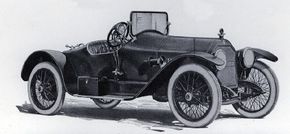In some ways, the 1915-1922 Stutz Bearcat was a labor of love. By the time Harry C. Stutz got around to the Bearcat, the car for which he is best remembered, he had been designing and building automobiles for at least six years.
In 1906 he had been associated with American Motors of Indianapolis, where he designed a small but pricey 35-40 horsepower four-cylinder touring car. It was not, persistent legend and published reports to the contrary, the underslung model for which American would later become famous. Rather, Harry's chassis was entirely conventional. But it was a relatively fast automobile for its time.
Advertisement
Leaving American Motors in 1907, Stutz signed on as chief engineer of the Marion Motor Car Company, another Indianapolis firm, best known at the time as builder of the Marion Flyer, but remembered now primarily for its sporty 1913 Bobcat.
Then in 1910, with the backing of a financier named Campbell, Stutz organized the Stutz Auto Parts Company for the purpose of manufacturing a transaxle of Harry's own design. The business evidently prospered, but Harry Stutz wanted to build a car of his own -- and he achieved that goal in 1911 with a racing machine, the very first Stutz car. Powered by a four-cylinder Wisconsin engine, driving through one of Harry's own transaxles, the racer bore no small resemblance to the later Bearcat.
Evidently Harry knew a thing or two about putting his name before the public, for he promptly announced that his car would go immediately, without trial runs or prior testing of any kind, to "the Brickyard," to take part in the first 500-mile race at the new Indianapolis Speedway.
Presumably he knew his car couldn't win, since a number of its competitors boasted much bigger, more powerful engines than the Stutz's 389-cubic-inch T-head. But he had as his driver Gil Anderson, a big, rugged Swede who had competed successfully as a member of the Marion racing team. So Harry expected that his car would at least place within the first 10.
It didn't. Anderson came in just out of the money, in llth place. Now when you think about it, that's not a bad record for a brand new, untried machine. Many a contestant failed to finish that grueling run at all. And the Stutz's time was creditable enough: 500 miles in 442 minutes, with, in Harry Stutz's words, "not a single mechanical adjustment." Flat tires didn't count, of course, and the Stutz had several of those, each one causing a delay while Anderson headed for the pits.
Learn about the creation of the 1915 Stutz Bearcat on the next page.
Want more information on cars? See:
- Classic Cars
- Muscle Cars
- Sports Cars
- Consumer Auto Guide
- Consumer Auto Guide Used Car Search
Advertisement
